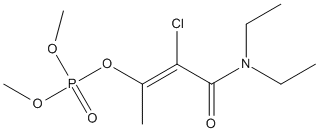Phosphamidon
General
Type : Organophosphate,Insecticide
Chemical_Nomenclature : [(Z)-3-chloro-4-(diethylamino)-4-oxobut-2-en-2-yl] dimethyl phosphate
Canonical SMILES : CCN(CC)C(=O)C(=C(C)OP(=O)(OC)OC)Cl
InChI : InChI=1S\/C10H19ClNO5P\/c1-6-12(7-2)10(13)9(11)8(3)17-18(14,15-4)16-5\/h6-7H2,1-5H3\/b9-8-
InChIKey : RGCLLPNLLBQHPF-HJWRWDBZSA-N
Other name(s) : Phosphoric acid 2-chloro-3-(dimethylamino)-1-methyl-3-oxo1-propenyl dimethyl ester,2-chloro-2-diethylcarbamoyl-1-methylvinyl dimethyl phosphate,2-chloro-3-dimethoxyphosphinoyloxy-N,N-diethylbut-2-enamide,2-chloro-3-(diethylamino)-1-methyl-3-oxo-1-propenyl dimethyl phosphate,Dimecron,Dixon,ML 97,C 570
MW : 299.69
Formula : C10H19ClNO5P
CAS_number : 13171-21-6
PubChem : 3032604
UniChem : RGCLLPNLLBQHPF-HJWRWDBZSA-N
IUPHAR :
Wikipedia : Phosphamidon

Target
References (4)
| Title : Apoptosis in male germinal line cells of rat in vivo: caused by phosphamidon - Akbarsha_1997_Cytobios_91_33 |
| Author(s) : Akbarsha MA , Sivasamy P |
| Ref : Cytobios , 91 :33 , 1997 |
| Abstract : Akbarsha_1997_Cytobios_91_33 |
| ESTHER : Akbarsha_1997_Cytobios_91_33 |
| PubMedSearch : Akbarsha_1997_Cytobios_91_33 |
| PubMedID: 9569619 |
| Title : Safety\/risk assessment of pesticides: principles, procedures and examples - Lu_1992_Toxicol.Lett_64_783 |
| Author(s) : Lu FC , Dourson ML |
| Ref : Toxicol Lett , 64-65 :783 , 1992 |
| Abstract : Lu_1992_Toxicol.Lett_64_783 |
| ESTHER : Lu_1992_Toxicol.Lett_64_783 |
| PubMedSearch : Lu_1992_Toxicol.Lett_64_783 |
| PubMedID: 1471237 |
| Title : Zinc chloride-diphenylamine reagent for thin layer chromatographic detection of some organophosphorus and carbamate insecticides - Sevalkar_1991_J.Assoc.Off.Anal.Chem_74_545 |
| Author(s) : Sevalkar MT , Patil VB , Katkar HN |
| Ref : J Assoc Off Analytical Chemistry , 74 :545 , 1991 |
| Abstract : Sevalkar_1991_J.Assoc.Off.Anal.Chem_74_545 |
| ESTHER : Sevalkar_1991_J.Assoc.Off.Anal.Chem_74_545 |
| PubMedSearch : Sevalkar_1991_J.Assoc.Off.Anal.Chem_74_545 |
| PubMedID: 1874701 |
| Title : Isolation and concentration of organophosphorus pesticides from drinking water at the ng\/L level, using macroreticular resin - LeBel_1979_J.Assoc.Off.Anal.Chem_62_241 |
| Author(s) : LeBel GL , Williams DT , Griffith G , Benoit FM |
| Ref : J Assoc Off Analytical Chemistry , 62 :241 , 1979 |
| Abstract : LeBel_1979_J.Assoc.Off.Anal.Chem_62_241 |
| ESTHER : LeBel_1979_J.Assoc.Off.Anal.Chem_62_241 |
| PubMedSearch : LeBel_1979_J.Assoc.Off.Anal.Chem_62_241 |
| PubMedID: 447594 |